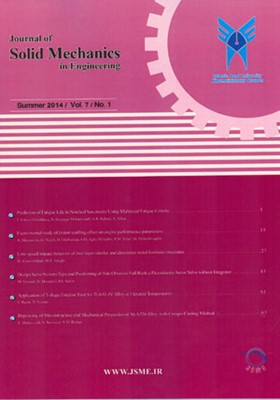Low-speed impact behavior of two-layer similar and dissimilar metal laminate structures
Subject Areas : Journal of Simulation and Analysis of Novel Technologies in Mechanical Engineering
هادی خرّمی شاد
1
*
![]() ,
محمد باقری توفیقی
2
,
محمد باقری توفیقی
2
1 - استادیار، دانشکده مهندسی مکانیک، دانشگاه علم و صنعت ایران
2 - کارشناسی ارشد، دانشکده مهندسی مکانیک، دانشگاه علم و صنعت ایران
Keywords: Finite Element Analysis, Metal Laminate Structure, Low speed Impact Loading, Adhesively Bonded Joints,
Abstract :
Mechanical behavior of two-layer metal laminate structures under low-speed impact loading was investigated experimentally and numerically. The experimental results were just used for validation of numerical results. Then numerical modeling was used to study the behavior of metal laminates in details. The mechanical behavior of the metal laminate structures under impact loading was found to be dependent on the material substance of the layers. The metal layers were made of four common materials used in the industry. Results showed that the maximum amount of contact force and minimum amount of contact duration for the metal laminate structures with similar metal layers were obtained when the layers were made of steel. Whereas, the maximum amount of displacement and dissipated energy were achieved for the structure with lead layers. For the structures in which the first metal layer was Al-6061T6, the maximum contact force obtained when the second metal layer was made of steel; and the maximum displacement occurred when the second metal layer was made of lead. It was found that the maximum mean amount of contact force belonged to the structures with first metal layer of steel and the maximum mean amount of displacement belonged to the structures with the first metal layer of lead. The finite element analysis results were in good agreement with the experimental results and also with the other researcher’s results.
1] Alic J.A., Stable crack growth in adhesively bonded aluminum alloy laminates, International Journal of Fracture, Vol. 11, No. 4, 1975, pp. 701-704.
[2] Johnson W.S., Stratton J.M., Effective remote stresses and stress intensity factors for an adhesive bonded multi-ply laminate, Engineering Fracture Mechanics, Vol. 9, No. 2, 1977, pp. 411-421.
[3] Marouf B.T., Bagheri R., Mahmudi R., Role of interfacial fracture energy and laminate architecture on impact performance of aluminum laminates, Composites Part A: Applied Science and Manufacturing, Vol. 39, No. 11, 2008, pp. 1685-1693.
[4] Crouch I., Adhesively-bonded Aluminium Laminates - Their Future as Energy-absorbing, Structural Materials, in Conference on New Materials and Processes for Mechanical Design (1988 : Brisbane, Qld.), Barton, ACT, 1988, pp. 21-26.
[5] Yildirim M., Apalak M.K., Transverse Low-Speed Impact Behavior of Adhesively Bonded Similar and Dissimilar Clamped Plates, Journal of Adhesion Science and Technology, Vol. 25, No. 1-3, 2011, pp. 69-91.
[6] Apalak M.K., Yildirim M., Effect of Adhesive Thickness on Transverse Low-Speed Impact Behavior of Adhesively Bonded Similar and Dissimilar Clamped Plates, Journal of Adhesion Science and Technology, Vol. 25, No. 19, 2011, pp. 2587-2613.
[7] Pacchione M., Hombergsmeier E., Hybrid Metal Laminates for Low Weight Fuselage Structures, in: S. Pantelakis, C. Rodopoulos, Engineering Against Fracture, 2009, pp. 41-57.
[8] Sinke J., Johansson S.A.H., Fatigue and Damage Tolerance Aspects of Metal Laminates, in: M. J. Bos, Bridging the Gap between Theory and Operational Practice, 2009, pp. 585-599.
[9] Tekyeh-Marouf B., Bagheri R., Fracture behavior of multi-layered composites under impact loading, Materials Science and Engineering, Vol. 448, No. 1, 2007, pp. 20-24.
[10] Katnam K.B., Crocombe A.D., Khoramishad H., Ashcroft I.A., The Static Failure of Adhesively Bonded Metal Laminate Structures: A Cohesive Zone Approach, Journal of Adhesion Science and Technology, Vol. 25, No. 10, 2011, pp. 1131-1157.
[11] Katnam K.B., Crocombe A.D., Sugiman S.,Khoramishad H., Ashcroft I.A., Static and Fatigue Failures of Adhesively Bonded Laminate Joints in Moist Environments, International Journal of Damage Mechanics, 2011.
[12] Qiao P., Yang M., Bobaru F., Impact Mechanics and High-Energy Absorbing Materials: Review, Journal of Aerospace Engineering, Vol. 21, No. 4, 2008, pp. 235-248.
[13] Khorshidi K., Elasto-Plastic Response of Impacted Moderatly Thick Rectangular Plates with Different Boundary Conditions, Procedia Engineering, Vol. 10, No. 0, 2011, pp. 1742-1747.
[14] Lu G., Yu T., Energy Absorption of Structures and Materials, Woodhead Publishing Limited, 2003, pp. 58-59.
[15] Quesada A., Gauchia A., Alvarez Caldas C., San Roman J.L., Influence of the Parameters of the Material Model in Finite Element Simulation of Sheet Metal Stamping, in 7th EUROMECH Solid Mechanics Conference, Lisbon, Portugal, 2009.
[16] Buchar J., Rolc S., Voldrich J., Lazar M., Starek M., The Development of the Glass Laminates Resistant to the Small Arms Fire, 19th International Symposium of Ballistics, Interlaken, Switzerland, 2001.
[17] Raviraj S., Laxmikant K., Pai R., Rao S.S., Finite Element Modeling of Stress Distribution in the Cutting Path in Machining of Discontinuously Reinforced Aluminum Composites, ARPN Journal of Engineering and Applied Sciences, Vol. 3, No. 4, 2008, pp. 25-31.
[18] Rincon L.F.T., Analysis and Performance of Adhesively Bonded Crush Tube Structures, University of Waterloo, 2012.
[19] Goda Y., Sawa T., Study on the Effect of Strain Rate of Adhesive Material on the Stress State in Adhesive Joints, The Journal of Adhesion, Vol. 87, 2011, pp. 766-779.

